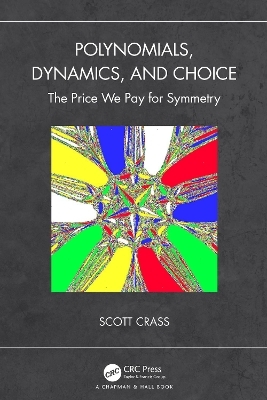
Polynomials, Dynamics, and Choice
Chapman & Hall/CRC (Verlag)
978-0-367-56520-6 (ISBN)
Working out solutions to polynomial equations is a mathematical problem that dates from antiquity. Galois developed a theory in which the obstacle to solving a polynomial equation is an associated collection of symmetries. Obtaining a root requires "breaking" that symmetry. When the degree of an equation is at least five, Galois Theory established that there is no formula for the solutions like those found in lower degree cases. However, this negative result doesn't mean that the practice of equation-solving ends. In a recent breakthrough, Doyle and McMullen devised a solution to the fifth-degree equation that uses geometry, algebra, and dynamics to exploit icosahedral symmetry.
Polynomials, Dynamics, and Choice: The Price We Pay for Symmetry is organized in two parts, the first of which develops an account of polynomial symmetry that relies on considerations of algebra and geometry. The second explores beyond polynomials to spaces consisting of choices ranging from mundane decisions to evolutionary algorithms that search for optimal outcomes. The two algorithms in Part I provide frameworks that capture structural issues that can arise in deliberative settings. While decision-making has been approached in mathematical terms, the novelty here is in the use of equation-solving algorithms to illuminate such problems.
Features
Treats the topic—familiar to many—of solving polynomial equations in a way that’s dramatically different from what they saw in school
Accessible to a general audience with limited mathematical background
Abundant diagrams and graphics.
Scott Crass is a professor of mathematics at California State University, Long Beach, where he created the Long Beach Project in Geometry and Symmetry. The project’s centerpiece is The Geometry Studio, where students explore math in experimental and perceptual ways. Advised by Peter Doyle, his Ph.D. thesis at UCSD was ‘Solving the Sextic by Iteration: A Complex Dynamical Approach’. His research interests involve blending the algebra and geometry induced by finite group actions on complex spaces, in an effort to discover and study symmetrical structures and associated dynamical systems. A prominent feature of his work involves using maps with symmetry in order to construct elegant algorithms that home in on a polynomial’s roots.
Section I. Polynomials: Symmetries and Solutions. 1. Solving Equations: A Fundamental Problem. 1.1. Polynomial Primer. 1.2. What Numbers Do We Use? 1.3. Roots And Coefficients. 2. What is Symmetry? 2.1. Mirrors and Reflections. 2.2. Mathematical Symmetry. 2.3. Exploring Geometric Symmetry. 2.4. Groups in the Abstract. 2.5. Posing and Solving Problems with Symmetry. 2.6. Structure in the Abstract. 2.7. A look at Higher Dimensions. 2.8. What is Geometry? 2.9. Molecular Symmetry. 2.10. Conservation Laws. 2.11. Thermodynamic Systems. 3. Geometry of Choice: Symmetry’s Cost. 3.1. Spaces Where the Roots Live. 3.2. Shuffling Roots and Solving Equations. 4. Compute First, Then Choose. 4.1. Simplifying a Polynomial. 4.2. Solutions from a Formula and a Choice. 4.3. Reducing a Polynomial’s Symmetry. 4.4. What Goes Wrong. 5. Choose First, Then Compute. 5.1. A Line that becomes a Sphere. 5.2. Symmetrical Structures. 5.3. Fundamentals of Dynamics. 5.4. Dynamical Geometry and Symmetry. 5.5. Solving Equations by Iteration. Section II. Beyond Equation. Chapter 6. Interlude: Modeling Choice. 7. Learning to Choose. 7.1. Making Rational Decisions. 7.2. The Heart Has its Reasons. 7.3. Give Chance a Choice. 8. Choosing to Learn. 8.1. A Crowd Decides. 8.2. When in Doubt, Simulate. 8.3. Give Choice a Chance. 9. Conclusion. 9.1 Symmetry, More or Less. 9.2. Choosing As Metaphor. 9.3 Random Choice is Unavoidable.
| Erscheinungsdatum | 17.08.2022 |
|---|---|
| Zusatzinfo | 18 Tables, black and white; 49 Line drawings, color; 9 Line drawings, black and white; 49 Illustrations, color; 9 Illustrations, black and white |
| Sprache | englisch |
| Maße | 156 x 234 mm |
| Gewicht | 412 g |
| Themenwelt | Mathematik / Informatik ► Mathematik ► Allgemeines / Lexika |
| Mathematik / Informatik ► Mathematik ► Algebra | |
| Mathematik / Informatik ► Mathematik ► Analysis | |
| Mathematik / Informatik ► Mathematik ► Geometrie / Topologie | |
| ISBN-10 | 0-367-56520-X / 036756520X |
| ISBN-13 | 978-0-367-56520-6 / 9780367565206 |
| Zustand | Neuware |
| Haben Sie eine Frage zum Produkt? |
aus dem Bereich


